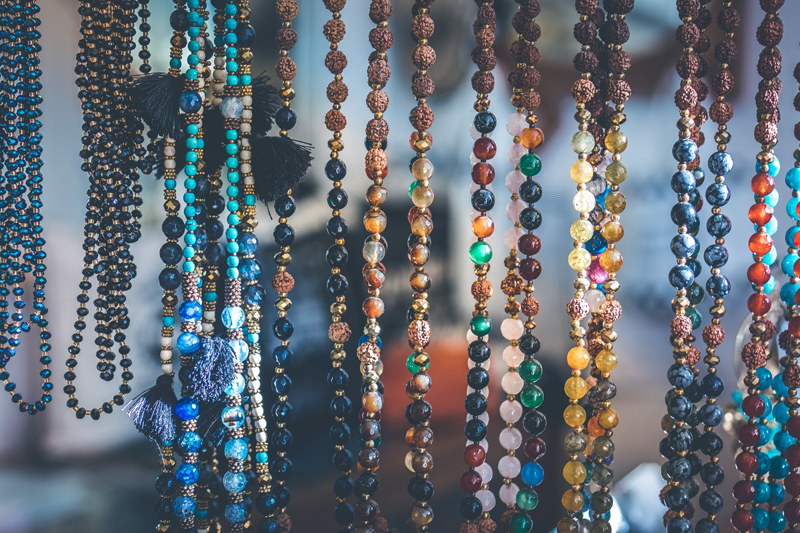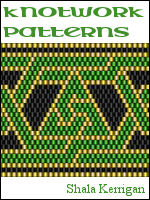Graphing Patterns - Mandalas

What is a mandala? Our New Age editor, Laura D'Silva answers the question here.
Without working in the round it's hard to make truly round shapes with seed beads, so the mandalas here are actually based on hexagons. Hexagons are a natural, easy shape to make in brick stitch or odd count peyote, and are easy to make a symmetrical 6 sided design in. You start with graph paper that you mark off into 6 sections. You can download and print this graph paper to use in creating your own patterns. This graph paper is 35 beads wide, which makes a good size for a pendant.

You can either start with an idea in mind, like a flower, or just start making shapes in one pie shaped piece. I decided on a flower, so started by graphing one petal.

Now, you'll notice that the petal is at an angle, and it's easy to see how to do the 4 angles that match, but 2 of the angles are different. That's what the marked are for, using as guidelines to create each section.

Continue marking each section with your petals.

Now you have the outline of your flower. Time to add some details. I decided on leaves.

I put them in each section, and looked at the final shape. I decided I wasn't really happy with the shape of the leaves and changed it slightly. There is something very relaxing about graphing symmetrical designs. This is called radial symmetry if you're interested. Where something is symmetrical going around in a circle. Start with a shape, add more shapes, after you get the section the way you like it, repeat the design around.
When I finished with my design, it looked like this.

Example beaded by Jennifer Bragg.

This design also has bilateral symmetry, which means the sides are a mirror to each other. But the technique works with designs that don't have that sort of symmetry, such as this very simple key to my heart design. You can see the keys only have teeth on one side, but that side points in the same direction all the way around. Also instead of a symmetrical design in the middle, I put a keyhole.

The same technique also works for 3 sided designs because 3 divides evenly into six. You'll set up your design on alternating guidelines like the triskelion shown below. You'll see the guidelines it's set up on marked in red.

Then you can add more designs into the spaces between.

This is the method I use to graph all my snowflake and kaleidescope designs, as well as how I graph triquetra or triangle knots.
I hope you enjoyed this article and that you'll graph lots of pretty things!

Knotwork patterns is my collection of knotted odd count peyote patterns for earrings, bracelets and barrettes. Lots of patterns for only 3 dollars.
You can also get a collection of mandala like patterns from my Etsy shop, here.
Without working in the round it's hard to make truly round shapes with seed beads, so the mandalas here are actually based on hexagons. Hexagons are a natural, easy shape to make in brick stitch or odd count peyote, and are easy to make a symmetrical 6 sided design in. You start with graph paper that you mark off into 6 sections. You can download and print this graph paper to use in creating your own patterns. This graph paper is 35 beads wide, which makes a good size for a pendant.

You can either start with an idea in mind, like a flower, or just start making shapes in one pie shaped piece. I decided on a flower, so started by graphing one petal.

Now, you'll notice that the petal is at an angle, and it's easy to see how to do the 4 angles that match, but 2 of the angles are different. That's what the marked are for, using as guidelines to create each section.

Continue marking each section with your petals.

Now you have the outline of your flower. Time to add some details. I decided on leaves.

I put them in each section, and looked at the final shape. I decided I wasn't really happy with the shape of the leaves and changed it slightly. There is something very relaxing about graphing symmetrical designs. This is called radial symmetry if you're interested. Where something is symmetrical going around in a circle. Start with a shape, add more shapes, after you get the section the way you like it, repeat the design around.
When I finished with my design, it looked like this.

Example beaded by Jennifer Bragg.

This design also has bilateral symmetry, which means the sides are a mirror to each other. But the technique works with designs that don't have that sort of symmetry, such as this very simple key to my heart design. You can see the keys only have teeth on one side, but that side points in the same direction all the way around. Also instead of a symmetrical design in the middle, I put a keyhole.

The same technique also works for 3 sided designs because 3 divides evenly into six. You'll set up your design on alternating guidelines like the triskelion shown below. You'll see the guidelines it's set up on marked in red.

Then you can add more designs into the spaces between.

This is the method I use to graph all my snowflake and kaleidescope designs, as well as how I graph triquetra or triangle knots.
I hope you enjoyed this article and that you'll graph lots of pretty things!

Knotwork patterns is my collection of knotted odd count peyote patterns for earrings, bracelets and barrettes. Lots of patterns for only 3 dollars.
You can also get a collection of mandala like patterns from my Etsy shop, here.
You Should Also Read:
Graphing Patterns
Basic Beading- Odd Count Flat Peyote
Snowflake Earrings

Related Articles
Editor's Picks Articles
Top Ten Articles
Previous Features
Site Map
Follow @shala%5Fbeads
Tweet
Content copyright © 2023 by Shala Kerrigan. All rights reserved.
This content was written by Shala Kerrigan. If you wish to use this content in any manner, you need written permission. Contact Shala Kerrigan for details.






